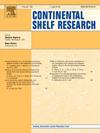受人工海滩营养物影响的海洋地区无机水质评估:巴西东北部的案例研究
IF 2.2
3区 地球科学
Q2 OCEANOGRAPHY
引用次数: 0
摘要
本研究考察了人工海滩营养项目对巴西塞埃尔本文章由计算机程序翻译,如有差异,请以英文原文为准。

Assessment of inorganic water quality in marine areas affected by an artificial beach nourishment: A case study in northeastern Brazil
This study examines the impact of an artificial beach nourishment project on seawater quality at two beaches in Fortaleza, Ceará, Brazil. The research was conducted between October 2019 and May 2022. Twenty-seven inorganic water quality parameters were analyzed in five phases: at the beginning, during execution and in three phases after completion of the works. The distribution of chemicals in the marine sediment was also analyzed. The water analysis showed that the average concentrations of four parameters were above the maximum permissible values (MPV) established by the Brazilian standard in at least one phase of the study. The fluoride concentration reached 2.4 mg/L, exceeding the MPV of 1.4 mg/L. Polyphosphates recorded a maximum value of 0.085 mg/L, exceeding the MPV of 0.031 mg/L, while hydrogen sulfide reached 0.0023 mg/L, exceeding the MPV of 0.0020 mg/L. Total residual chlorine showed average concentrations above the MPV of 0.01 mg/L in all phases of the study, with a maximum value of 0.64 mg/L. On the basis of this study, there is no concrete evidence that the concentrations above the MPV are due to the artificial beach nourishment, as these concentration peaks were not only observed in the samples taken during the execution phase of the work. Furthermore, no significant permanent changes in the physical and chemical properties of the water were detected after the end of the work. The statistical differences observed in the inorganic water quality parameters can be attributed to the marine dynamics in the region, such as strong currents, mixing of water masses and the tidal regime. In addition, the study area is influenced by various anthropogenic activities that can contribute significantly to these changes. The analysis of metals and nutrients in the sediment revealed concentrations below the limits established by the Brazilian standard.
求助全文
通过发布文献求助,成功后即可免费获取论文全文。
去求助
来源期刊

Continental Shelf Research
地学-海洋学
CiteScore
4.30
自引率
4.30%
发文量
136
审稿时长
6.1 months
期刊介绍:
Continental Shelf Research publishes articles dealing with the biological, chemical, geological and physical oceanography of the shallow marine environment, from coastal and estuarine waters out to the shelf break. The continental shelf is a critical environment within the land-ocean continuum, and many processes, functions and problems in the continental shelf are driven by terrestrial inputs transported through the rivers and estuaries to the coastal and continental shelf areas. Manuscripts that deal with these topics must make a clear link to the continental shelf. Examples of research areas include:
Physical sedimentology and geomorphology
Geochemistry of the coastal ocean (inorganic and organic)
Marine environment and anthropogenic effects
Interaction of physical dynamics with natural and manmade shoreline features
Benthic, phytoplankton and zooplankton ecology
Coastal water and sediment quality, and ecosystem health
Benthic-pelagic coupling (physical and biogeochemical)
Interactions between physical dynamics (waves, currents, mixing, etc.) and biogeochemical cycles
Estuarine, coastal and shelf sea modelling and process studies.
 求助内容:
求助内容: 应助结果提醒方式:
应助结果提醒方式:


